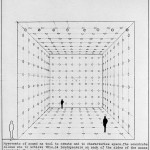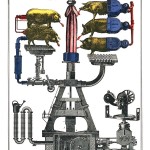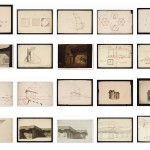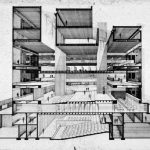Between 1967 and 1969, Dutch conceptual artist Jan Dibbets created a series of works, consisting of photographs of walls, floors and lawns, titled “Perspective Correction”. In each canvas a square or a circle is drawn in pencil, tape or directly dug into the ground.
The precise geometrical forms were obtained through three-dimensional illusion, as in reality they were trapezoid or ellipsis appearing as squares or circles through oblique perspective.
Whereas the canvas focuses only on the photo, in some rarer versions on paper of Perspective Corrections (see the last image in this post), the artist records the phases of his research: from the tape used to outline the geometric form in the space to the angle adoped to obtain the “perspective correction”.
The conceptual art pieces address the themes of illusion in art and photography, the gap between perception (what the eye sees) and representation (what the camera sees), the nature of the art object and the role of photography: from a passive medium used by Land artists for documenting ephemeral acts, to an active tool through which to question the intellectual construction of space, an issue that dominated Western art since the Renaissance.
“The camera records something quite different from what we see. There are no rectangular formats in nature, only in art (paintings, sheets of music or poems, windows, ravioli), and only if we choose to look at it that way. For Perspective Correction, My Studio I, 1: Square on Floor, 1969, the earliest work in the show, Jan Dibbets drew an upside-down trapezoid (in relation to the camera) on his studio floor and took a photograph (the work) so that the trapezoid, distorted by perspective, appears to be a square. It’s difficult not to think of it as a square, and no reason not to, despite the inward-slanting walls. In a way it is a joke about the preeminence of the picture plane in contemporary art, whereas, of course, the perception of Renaissance perspective still prevails, or at least still resides, or better yet is still the place where we and the artist reside. Despite the square, our eyes take us into depth to the windows and their light. There are windows within a window presaged by another window. Without really destroying our illusions, the artist has interrupted reality, or intervened to almost imperceptibly create another reality, something in the back of the mind that forces us to accept both realities. The artist introduces himself (takes control?) by making a square out of a trapezoid in his own studio. The trick is an elementary one, a wan display of the human imagination. But it suggests something more elemental, in itself and in works to come.” – Donald Goddard
Further reading:
An introduction to Jan Dibbets’ retrospective at Castello di Rivoli (Turin)
Correcting perspectives: Jan Dibbets and an optical conceptualism by Coyne, Mary L., M.A., California State University, Long Beach, 2013, 138 pages
Jan Dibbets in conversation with Sharon Boothroyd London, UK Interview conducted by phone 19 April 2013
Photography, and the The Dematerialization of the art object, in Photo & Poetry
Perspective Collections at Alan Cristea Gallery
A collection of similar (posterior) works by other artists.






Leave a Reply